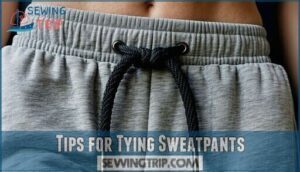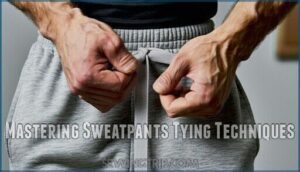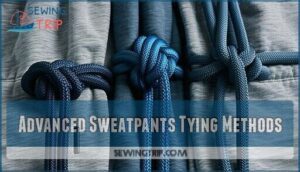This site is supported by our readers. We may earn a commission, at no cost to you, if you purchase through links.
 Learning how to tie sweatpants correctly keeps them snug and comfortable all day.
Learning how to tie sweatpants correctly keeps them snug and comfortable all day.
Start by pulling both drawstring ends evenly to create proper tension around your waist.
Make a simple overhand knot by crossing the right string over the left, then pull the right end through the loop.
Tighten gently—you want security without cutting off circulation.
Next, create bunny ears with both ends and tie them together like shoelaces.
The key is finding that sweet spot between too loose and too tight.
Your sweatpants should feel secure but still allow easy movement and breathing.
Different drawstring types require slightly different approaches for the best results.
Table Of Contents
- Key Takeaways
- Tying Sweatpants Made Easy
- How to Tie Sweatpants Drawstring
- Types of Sweatpants Drawstrings
- Tying a Sweatpants Knot
- Common Sweatpants Knots
- Tips for Tying Sweatpants
- Troubleshooting Sweatpants Tying Issues
- Mastering Sweatpants Tying Techniques
- Advanced Sweatpants Tying Methods
- Frequently Asked Questions (FAQs)
- Conclusion
Key Takeaways
- You’ll create a secure base by crossing your drawstring ends to form an "X" shape, then wrapping the left string around the right several times before pulling it through—this prevents constant readjustments throughout the day.
- You should aim for the sweet spot between too loose and too tight by adjusting tension until you can slide two fingers between the waistband and your body, ensuring comfort without circulation issues.
- You can master different drawstring types by using specific techniques—continuous loops need tucking into the waistband, two-end strings require even lengths, and closed loops work best with knotless adjustments.
- You’ll build muscle memory and speed by practicing the same knot technique daily for just five minutes, focusing on smooth movements rather than rushed attempts to make tying automatic.
Tying Sweatpants Made Easy
You can master sweatpants tying with simple techniques that keep your waistband secure and comfortable all day.
Learning the right knots and adjustments prevents embarrassing slips and guarantees your sweatpants fit perfectly every time, which is crucial for a comfortable experience.
Importance of Tying Sweatpants Correctly
Tying your sweatpants’ drawstring correctly isn’t just about avoiding fashion faux pas—it’s essential for comfort and functionality.
Master your drawstring, master your comfort—because life’s too short for constantly falling pants.
A secure knot prevents constant adjustments and guarantees your pants stay put during activities.
Here’s why proper tying matters:
- Comfort and Fit: Eliminates uncomfortable slipping and bunching
- Waistband Security: Keeps drawstring positioned for ideal support
- Knot Longevity: Prevents frequent retying throughout the day
Benefits of Mastering Sweatpants Tying
When you master proper drawstring tying techniques, you gain Enhanced Comfort and Improved Fit that transforms your daily wear experience.
Secure sweatpants with the right knot offer Style Versatility for any occasion while eliminating constant waistband adjustments.
These essential tying techniques Prevent Slippage during workouts, errands, or lounging sessions.
Most importantly, knowing your sweatpants will stay perfectly positioned throughout the day builds Increased Confidence, letting you focus on what matters most.
How to Tie Sweatpants Drawstring
Learning the right sweatpants drawstring technique transforms your comfort experience from frustrating adjustments to effortless wearability.
Your drawstring knot serves as the foundation for secure sweatpants that won’t betray you during daily activities.
Start by pulling both ends evenly until you achieve your desired waistband tightness.
Cross the strings to form an "X" shape, then wrap the left string around the right several times.
Create a second crossing point about 1.5 inches ahead, bringing the left string through this new loop.
Tighten by tugging the left string to eliminate slack.
This tying technique offers excellent knot security while maintaining drawstring aesthetics.
The adjustable design allows you to slide the knot along the string for comfort considerations without retying.
- Knot lifespan: Your secure knot stays put through multiple wears and washes
- Tying variations: Master different methods for various drawstring types and personal preferences
- How to knot: Practice creates muscle memory for quick, reliable results every time
Types of Sweatpants Drawstrings
You’ll encounter three main drawstring types in sweatpants, each with unique tying methods and benefits.
The continuous loop, two-end, and closed loop drawstrings require different approaches to achieve a secure, comfortable fit that won’t slip during wear, utilizing a secure method.
Continuous Loop Drawstring
Continuous loop drawstrings offer athletic shorts-style convenience for your sweatpants.
This single-loop design eliminates loose ends, providing superior loop knot security compared to traditional two-end systems.
The seamless construction prevents fraying and enhances loop material durability over time.
Adjusting loop length requires pulling the drawstring until you achieve ideal waistband tension.
| Feature | Benefit |
|---|---|
| Single loop design | No loose ends to manage |
| Seamless construction | Enhanced durability |
| Athletic-grade materials | Superior comfort |
| Adjustable tension | Custom fit control |
| Professional appearance | Clean, streamlined look |
For those interested, you can find drawstring product options for more information.
For hiding excess loop, tuck remaining cord inside the waistband channel.
These loop style variations work exceptionally well for active wear.
Two-End Drawstring
Most sweatpants feature two separate strings hanging from your waistband, making them straightforward to secure.
These drawstring ends require even length and proper technique for best results. Many options exist for sweatpants drawstring types.
- Even Length: Adjust both pants strings to identical lengths before tying
- Overlapping Ends: Cross strings forming an "X" shape at waistband center
- Twisted Ends: Wrap one string around the other for secure knots
- Bow Tying: Complete with standard shoelace knot technique
Closed Loop Drawstring
With closed loop drawstrings, you’re getting the best of both worlds: loop security and material durability without loose ends flopping around.
This drawstring style forms one continuous circle that won’t slip through eyelets or get lost in the wash. While you can’t tie traditional knots, you’ve got knotless options that work brilliantly. Simply adjust the loop’s tightness and tuck excess cord into your waistband.
You can find various related products online. The comfort factors and style integration make these perfect for sweatpants when you want reliable fit without fussy drawstring knot maintenance.
Pros & Cons Alternatives
Tying a Sweatpants Knot
You’ll create a secure knot by combining three essential steps that work together to keep your sweatpants properly fitted around your waist.
This method guarantees your drawstring stays tight throughout the day, preventing any embarrassing slippage during activities, which ensures a secure fit.
Creating a Base Knot
Building your sweatpants’ secure foundation starts with proper initial tension on the drawstring. Think of this base knot as your anchor—it prevents everything from unraveling during daily activities.
Here’s how to nail knotting materials and placement importance:
- Cross the strings to form an "X" shape, pulling them taut
- Wrap the left string behind and around the right string several times
- Position the knot at the waistband’s base for maximum stability
- Test the tension by gently tugging to guarantee knot longevity
This drawstring knot foundation guarantees your sweatpants stay put all day long.
Making a Bunny Ear
Your base knot provides the foundation—now create those signature bunny ear loops.
Hold your drawstring ends and form two identical loops, ensuring perfect loop symmetry. Loop orientation matters: keep them parallel to your waistband for ideal aesthetic appeal.
Size each ear equally for balanced tying security. This classic bunny ear knot transforms basic sweatpants tying methods into something both functional and stylish.
Tightening The Knot
After creating your bunny ear loops, you’ll need to master the art of Tension Control to prevent Knot Slippage. Grab both loops firmly and pull them in opposite directions until you feel resistance. This creates a Secure Foundation that won’t budge during daily activities.
Adjusting Tightness requires patience—tug gently while testing the waistband fit around your midsection. Your sweatpants should feel snug but never restrictive. The drawstring knot should sit flat against your waist without digging in.
Maintaining Comfort means finding that sweet spot where your pants stay up without cutting off circulation. Pull the drawstring until you can slide two fingers between the waistband and your body. This technique helps you tighten pants effectively while ensuring all-day comfort.
Common Sweatpants Knots
You’ll master three essential knot types that keep your sweatpants secure and comfortable throughout the day.
These reliable techniques work with different drawstring styles, ensuring you never face the embarrassment of sagging pants again.
Tying a Taut Line Hitch Knot
The taut line hitch transforms your sweatpants drawstring into an adjustable powerhouse. This versatile drawstring knot creates secure tension while allowing easy adjustments.
Cross your strings, wrap twice through the triangular opening, then pull tight. The release mechanism lets you slide the knot for perfect fit without retying.
- Adjustable Hitch design prevents constant retying and readjusting throughout the day
- Secure Tension keeps your sweatpants snug without creating uncomfortable pressure points
- Knot Applications work perfectly for athletic activities requiring consistent waistband support
- Release Mechanism allows quick loosening after workouts or meals without untying completely
- Alternative Hitches provide backup options when standard bow ties fail or slip
Tying a Single Loop Drawstring
When facing a single loop drawstring, you’re dealing with one continuous cord that requires a different approach.
Pull the loop away from your waist until the sweatpants feel snug.
Create two sections from the loop, then tie them using a standard shoelace knot for maximum loop knot security.
| Technique | Benefit |
|---|---|
| Loop sectioning | Creates manageable tie points |
| Shoelace method | Familiar, reliable knot |
| Tension adjustment | Customizable waistband fit |
This approach allows for tension adjustment, enabling a customizable waistband fit.
Tying a Two-End Drawstring
Two-end drawstrings require even length on both sides for ideal results.
Pull both ends until your sweatpants feel snug, then overlap twist the strings to start your bow tie. Material choice affects how well secure knots hold, so adjust accordingly.
These clothing hacks work with any drawstring:
- Keep strings equal length before tying
- Create firm foundation with base knot
- Form loops carefully for lasting hold
- Test tightness before finishing pants strings
Tips for Tying Sweatpants
You’ll achieve the perfect fit when you select the right drawstring material, position your knot correctly, and use proper tension techniques.
These essential tips will keep your sweatpants secure and comfortable throughout your day, preventing the frustrating slips and gaps that cause waistband problems.
Choosing The Right Drawstring
When selecting your sweatpants drawstring, material durability directly impacts performance.
Cotton offers comfort but nylon provides superior knot security. Cord length should allow comfortable tying without excessive slack.
Consider comfort factors like thickness—thicker strings handle tension better and prevent cutting into your waist.
For style matching, choose colors that complement your sweatpants.
Quality drawstring material guarantees your drawstring replacement lasts longer.
Adjusting The Knot
After selecting your ideal drawstring, you’ll need to master knot placement and tension control.
Position your knot about an inch from the waistband for ideal comfort maximization. Pull the strings until your sweatpants feel snug but not restrictive—think of it like adjusting a belt to the perfect notch.
Test for waistband gaps by sitting and standing. If the drawstring knot security feels loose, slide it closer to your waist.
Proper slippage prevention means finding that sweet spot where comfort meets control for lasting drawstring knot durability.
Preventing Knots From Coming Undone
Nobody wants their sweatpants sliding down mid-stride.
Secure knotting starts with proper knot placement directly against the waistband for maximum friction enhancement. Material properties matter—cotton and nylon cords grip better than slippery synthetics.
Here’s your drawstring knot security checklist:
- Perfect knot tightness—snug but not cutting circulation
- Strategic tying techniques—use wrapping methods for extra grip
- Optimal string length—trim excess to prevent loosening
- Regular maintenance—retighten after washing
Troubleshooting Sweatpants Tying Issues
Even perfect sweatpants knots can develop problems like loose waistbands, gaps, or strings that won’t stay tight.
You’ll find simple solutions to fix these common issues and keep your sweatpants secure all day long.
Fixing a Gap in The Waistband
Your sweatpants drawstring can’t fix everything when the waistband is genuinely too big.
Here’s your action plan for waistband adjustment:
| Problem | Solution |
|---|---|
| Pants too big overall | Purchase correct size or tailor waistband |
| Elastic stretched out | Replace elastic through waistband channel |
| Drawstring length insufficient | Add longer cord or safety pin technique |
Perfect knot placement and tension control help, but sometimes you need alternative solutions beyond tying.
Dealing With Knots That Won’t Stay Tight
Loose sweatpants drawstring knots can ruin your comfort. Try looping around an extra time while making the X in your regular bow knot for better knot security. A taut line hitch provides superior friction enhancement over basic drawstring knots, preventing knot slippage through secure finishes.
Consider knot redesign based on your cord material for lasting results.
- Constant readjustment throughout the day
- Embarrassing waistband slippage in public
- Frustration from unreliable clothing
- Lost confidence in your comfort
Managing Short Strings
Short strings don’t have to ruin your sweatpants experience.
When your drawstring barely reaches around your waist, these creative solutions will save the day:
- Extending Strings – Attach a safety pin to feed the drawstring through the waistband completely, then tie on extra cord for proper length.
- Alternative Methods – Use shoelaces or paracord as string alternatives for better knot placement and security.
- Creative Solutions – Shape single-loop drawstrings into two sections for easier tying.
Mastering Sweatpants Tying Techniques
You’ll build confidence and speed by practicing different knots until your hands know exactly what to do without thinking.
Regular practice creates muscle memory that makes tying sweatpants quick and automatic, so you can secure your waistband in seconds every time, allowing for automatic actions.
Practicing Different Knots
Knot-mastery begins with systematic practice across different techniques. Start with basic shoelace knot variations, then progress to advanced methods like taut line hitches.
| Knot Type | Complexity Level | Best For |
|---|---|---|
| Basic Bow | Beginner | Daily wear |
| Square Knot | Intermediate | Secure hold |
| Taut Line | Advanced | Adjustability |
| Double Loop | Expert | Maximum security |
Regular tying frequency builds hand coordination. Style experimentation reveals your preferences while material impact affects knot performance on different drawstring types.
Developing Muscle Memory
The key to effortless sweatpants tying lies in repetitive tying sessions that build muscle memory through consistent practice.
Start with daily tying exercises, focusing on hand coordination and smooth movements.
Regular knotting drills improve hand dexterity while establishing your practice routine.
Through dedicated knot practice, your fingers will automatically know each step, making secure fastening feel natural and intuitive.
Improving Tying Speed
After developing muscle memory, focus on increasing your tying speed through targeted practice drills.
Hand coordination improves with daily repetition, making knot familiarity second nature. Efficient motions help you minimize slack quickly while securing your sweatpants drawstring.
Speed comes naturally when you:
- Perfect one drawstring technique before learning others
- Practice knot tying for just five minutes daily
- Focus on smooth, deliberate movements over rushed attempts
- Time yourself to track improvement milestones
Advanced Sweatpants Tying Methods
Once you’ve mastered basic sweatpants tying, you can explore specialized knots and materials that offer superior hold and comfort.
These advanced methods include alternative knot styles, custom drawstring materials, and personalized adjustments that prevent slipping while maintaining your preferred fit.
Using Alternative Knots
Once you’ve mastered basic techniques, alternative knots elevate your sweatpants drawstring game.
These knot variations offer enhanced security and style beyond standard ties.
Secure Knots prevent slippage while Decorative Knots add visual appeal.
Knot Complexity varies, affecting both function and appearance.
Material Impact influences knot performance, while Knot Lifespan depends on usage patterns.
| Knot Type | Security Level | Ease of Use | Best Material | Durability |
|---|---|---|---|---|
| Bowline | High | Moderate | Cotton cord | Excellent |
| Figure Eight | Very High | Easy | Nylon | Outstanding |
| Cleat Hitch | High | Difficult | Rope-style | Good |
| Trucker’s Hitch | Maximum | Hard | Thick cord | Superior |
| Ashley Stopper | Moderate | Easy | Any material | Fair |
Customizing Your Drawstring
You can transform your sweatpants drawstring into a personal style statement through strategic drawstring customization.
Consider drawstring length adjustment to achieve your perfect fit—shorter lengths create cleaner looks while longer ones offer more tying options.
Color options let you match or contrast with your sweatpants for visual interest.
Knot style becomes your signature move, whether you prefer simple bows or complex designs.
Tassel addition brings playful flair to plain drawstring ends, making each knot uniquely yours.
Exploring Different Materials
Your drawstring material affects both comfort and functionality in ways you’ll notice immediately.
Cotton drawstrings offer breathability, while polyester drawstrings resist wear. Nylon drawstrings provide exceptional durability factors that outlast most alternatives. Elastic drawstrings stretch with movement, and ribbon texture appeal adds visual interest.
Material tying ease varies substantially between options.
Consider these emotional benefits:
- Security: Never worry about knots loosening during activities
- Confidence: Feel assured your pants stay perfectly positioned
- Comfort: Experience all-day wearability without adjustments
- Style: Express personality through unique cord material impact
Frequently Asked Questions (FAQs)
How Tight Should the Drawstring Knot Be?
Like Goldilocks finding the perfect porridge, your drawstring knot shouldn’t be too loose or tight.
You’ll want it snug enough to prevent slipping but comfortable enough to breathe and move freely throughout your day.
Can I Use a Different Type of Knot?
You can absolutely experiment with different knots.
Try a bow tie for easy removal, a surgeon’s knot for extra security, or even decorative sailor knots for style.
Just make certain whatever you choose stays secure during movement, ensuring a secure fit.
Is There a Video Tutorial for the Correct Way to Tie the Drawstring?
Ironically, countless tutorials exist online, yet you’ll master drawstring tying faster with hands-on practice.
Search YouTube for "drawstring knot tutorial" or "sweatpants tying guide" to find visual demonstrations that’ll clarify each step perfectly.
Are There Any Other Methods to Tie a Continuous Loop Drawstring?
Yes, you can create a slip knot by pulling the loop cord three-quarters through, forming a secondary loop. This allows easy loosening without untying completely, perfect for quick adjustments.
Should Children Learn How to Tie the Drawstring in School?
Teaching children drawstring tying in schools isn’t necessary since it’s a simple life skill parents can easily demonstrate at home.
However, incorporating basic knot-tying into physical education could boost confidence and independence.
What’s the best way to tie sweatpants?
Cross your drawstring ends to form an "X," then wrap the left string around the right several times.
Create another "X" about 5 inches ahead, thread the left string through, and tighten for adjustable comfort.
How do you tie sweatpants?
Pull both drawstring ends away from your waistband until you achieve a snug fit.
Cross the left string under the right, then tie a simple bow knot like you’d tie your shoelaces.
How do you tie a drawstring sweatpant?
Simply secure your sweatpants by crossing the drawstring ends, wrapping one around the other, then pulling through to create a knot.
Adjust tightness by sliding the knot along the string for your perfect fit.
How do you tie a bow on a pair of sweatpants?
Hold both drawstring ends and cross them like you’re starting a regular knot.
Form a loop with one end, wrap the other around it, then pull through to create your bow tie.
How do I tie-dye a pair of sweatpants?
Want to turn boring sweatpants into colorful masterpieces?
You’ll need fabric dye, rubber bands, and gloves.
Twist or scrunch the fabric, secure with bands, apply dye, then rinse after the recommended setting time.
Conclusion
Like knights of old adjusting their armor, you’ve now mastered how to tie sweatpants properly.
These techniques guarantee your pants stay secure during any activity, from morning jogs to lazy afternoons.
Remember, the perfect knot balances comfort with functionality—tight enough to prevent slipping but loose enough for easy movement.
Practice different methods until you find your preferred style.
With these skills, you’ll never worry about wardrobe malfunctions again, and your sweatpants will stay exactly where they belong, providing easy movement.















